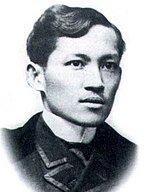Ilustrado
Enlightenment in the Philippines began with the Ilustrado, which is a Spanish and Filipino word that means the "enlightened one". [1] Philippine Ilustrados were the Filipino elite during the Spanish colonial period in the late 19th century. They were the middle-class who were educated and exposed to European liberal and nationalist ideals. The Filipino Ilustrados sought reform through “a more equitable arrangement of both political and economic power” under Spanish tutelage. Stanley Karnow, in his In Our Image: America’s Empire in the Philippines, referred to the Ilustrados as the “rich intelligentsia” because many were the children of wealthy landowners. They promoted nationalism in the Philippines.[1][2][3][4][5][6]
Ilustrado

The most prominent Ilustrados were Graciano López Jaena, Marcelo H. del Pilar, Mariano Ponce, Antonio Luna and José Rizal, the Philippine national hero. Rizal’s novels Noli Me Tangere (Touch Me Not) and El Filibusterismo (The Subversive) “exposed to the world the injustices imposed on Filipinos under the Spanish colonial regime”.[5][7]
In the beginning, Rizal and his fellow Ilustrados preferred not to win independence from Spain, instead they yearned legal equality for both Spaniards and Filipinos in the colony. Among the political, religious and economic reforms demanded by the Ilustrados were that “the Philippines be represented in the Cortes and be considered as a province of Spain” and “the secularization of the parishes”.[6][7]
However, in 1872, nationalist sentiment grew strongest, when three Filipino priests, “charged with leading a military mutiny at an arsenal in Cavite, near Manila”, were executed by the Spanish authorities. The event and “other repressive acts outraged the Ilustrados.[6] Because of his writings and activities, Rizal was executed by the Spaniards on December 30, 1896. Rizal’s execution propelled the Ilustrados to revolt against Spain. This also prompted unity among the Ilustrados and Andres Bonifacio’s Katipunan members.[6]

Philippine policies by the United States reinforced the dominant position of the Ilustrados within Filipino society. Friar estates were sold to the Ilustrados and most government positions were offered to them.[6]
Key figures of the Enlightenment in the Philippines
- Marcelo H. del Pilar (1850-1896)
- Felix Resurreccion Hidalgo
- Graciano López Jaena (1856-1896)
- Antonio Luna (1866-1899)
- Juan Luna (1857-1899)
- Mariano Ponce (1863-1918)
- José Rizal (1861-1896)
See also
- Spanish language in the Philippines
- Philippine Literature in Spanish
- Fernando María Guerrero
- The Thomasites
References
Specific
- ^ a b Glossary: Philippines, Area Handbook Series, Country Studies, Federal Research Division, Library of Congress, LOC.gov (undated), retrieved on: July 30, 2007
- ^ Grimsley, Mark. The Philippine War: 1899-1902, Ohio-State.edu, 1993, 1996, retrieved on: August 1, 2007
- ^ Karnow, Stanley. In Our Image: America’s Empire in the Philippines, Ballantine Books, Random House, Inc., March 3 1990, 536 pages, page 15. - ISBN 0-345-32816-7
- ^ The Rise of the Philippine Middle Class (Ilustrados), Mega Essays LLC, MegaEssays.com, 2007, retrieved on: August 1, 2007
- ^ a b Philippines: The Spanish Colony, Student Encyclopedia Article, Encyclopaedia Britannica Online, Encyclopaedia Britannica, Inc., Britannica.com, retrieved on: August 1, 2007
- ^ a b c d e History of the Philippines, Embassy of the Republic of the Philippines, Department of Foreign Affairs, PhilippineEmbassy-USA.org (undated), retrieved on: August 1, 2007
- ^ a b Salvador, Fr. Emerson, Liberalism in the Philippines, The Revolution of 1898: The Main Facts, Newsletter of the District of Asia, Society of St. Pius X, District of Asia, January - March 2002, retrieved on: August 1, 2007
General

- Republic of the Philippines, Microsoft Corporation, Encarta.MSN.com, 2007, retrieved on: August 1, 2007
- Exiles, Motherland and Social Change, Asian and Pacific Migration Journal (Bibliography), Volume 8, Issue 1-2, SMC.org.ph, (undated), retrieved on: August 1, 2007
- Owen, Norman G., Compadre Colonialism: Studies in the Philippines Under American Rule, A Review by Theodore Friend, The Journal of Asian Studies, Vol. 32, No. 1 (Nov., 1972), pp. 224-226, JSTOR.org, 2007, retrieved on: August 1, 2007
- Majul, Cesar A. The Political and Constitutional Ideas of the Philippine Revolution, A Review by R. S. Milne, Pacific Affairs, Vol. 42, No. 1 (Spring, 1969), pp. 98-99, JSTOR.org, 2007, retrieved on: August 1, 2007
- Proclamation of Philippine Independence and the Birth of the Philippine Republic, The Philippine History Site, OpManong.SSC.Hawaii.edu (undated), retrieved on: August 1, 2007
- Rossabi, Amy. The Colonial Roots of Civil Procedure in the Philippines, Volume 11, Number 1, Fall 1997, The Journal of Asian Law, Columbia.edu, retrieved on: August 1, 2007
- Filipino Nationalism, AngelFire.com (undated), retrieved on: August 1, 2007
- Veneracion, Jaime B., Ph. D. (Professor of History, University of the Philippines and Visiting Professor, BSU), Rizal's Madrid: The Roots of the Ilustrado Concept of Autonomy, Diyaryo Bulakenya, Bahay Saliksikan ng Bulakan (Center for Bulacan Studies), Geocities.com, April 4, 2003, retrieved on: August 1, 2007
- Philippine History, Philippine Children's Foundation, PhilippineChildrensFoundation.org, 2005, retrieved on: August 1, 2007
